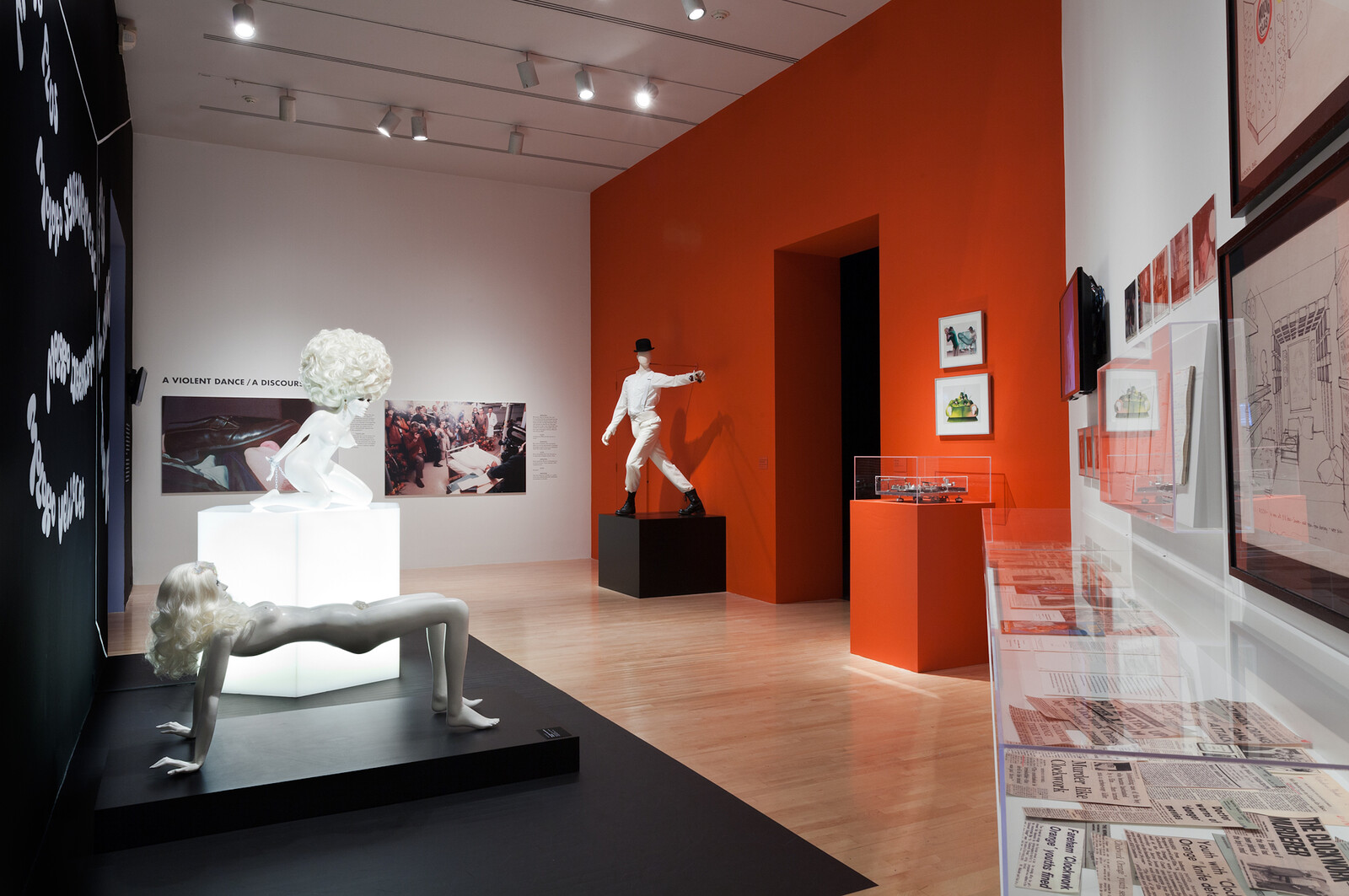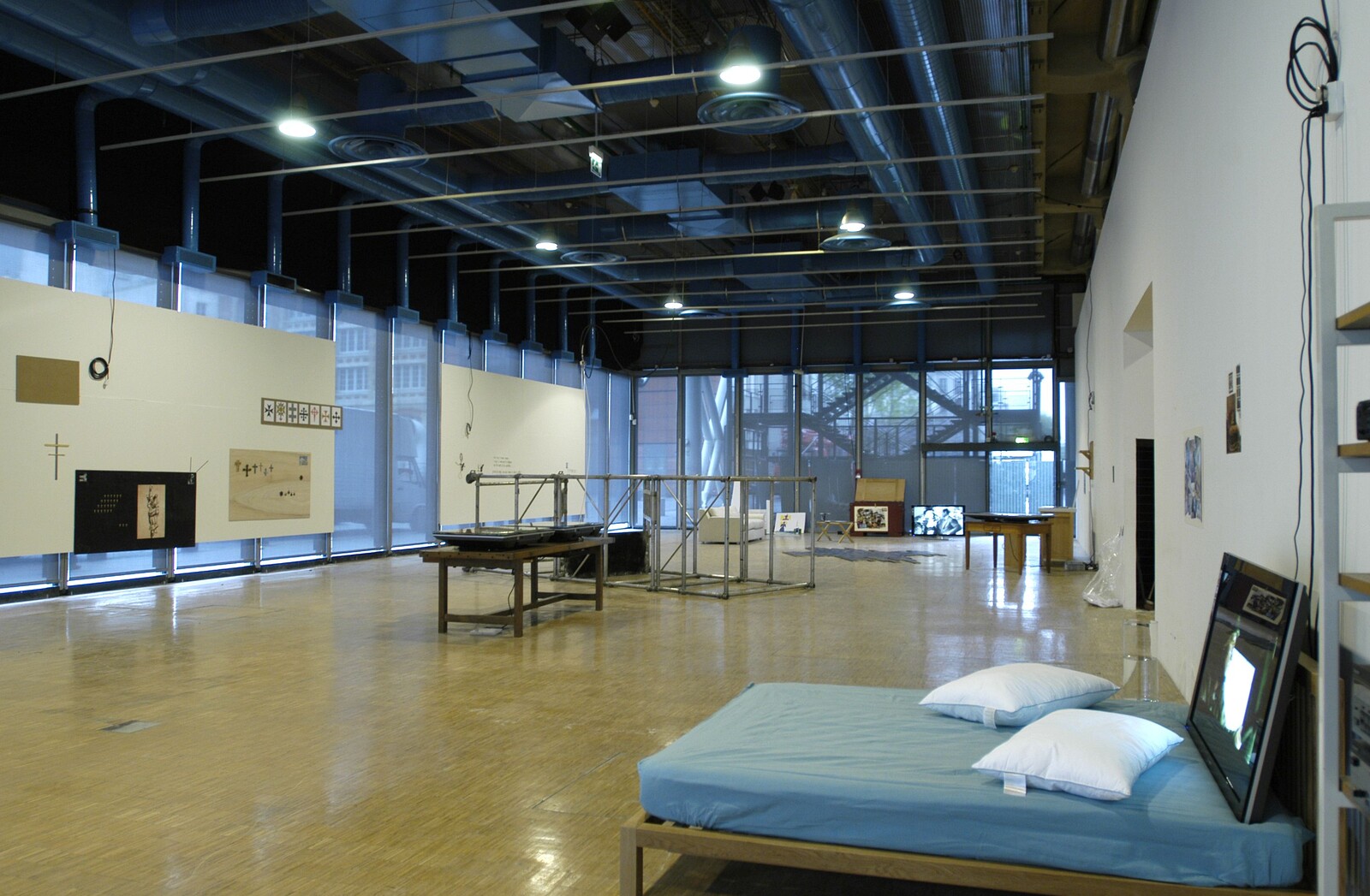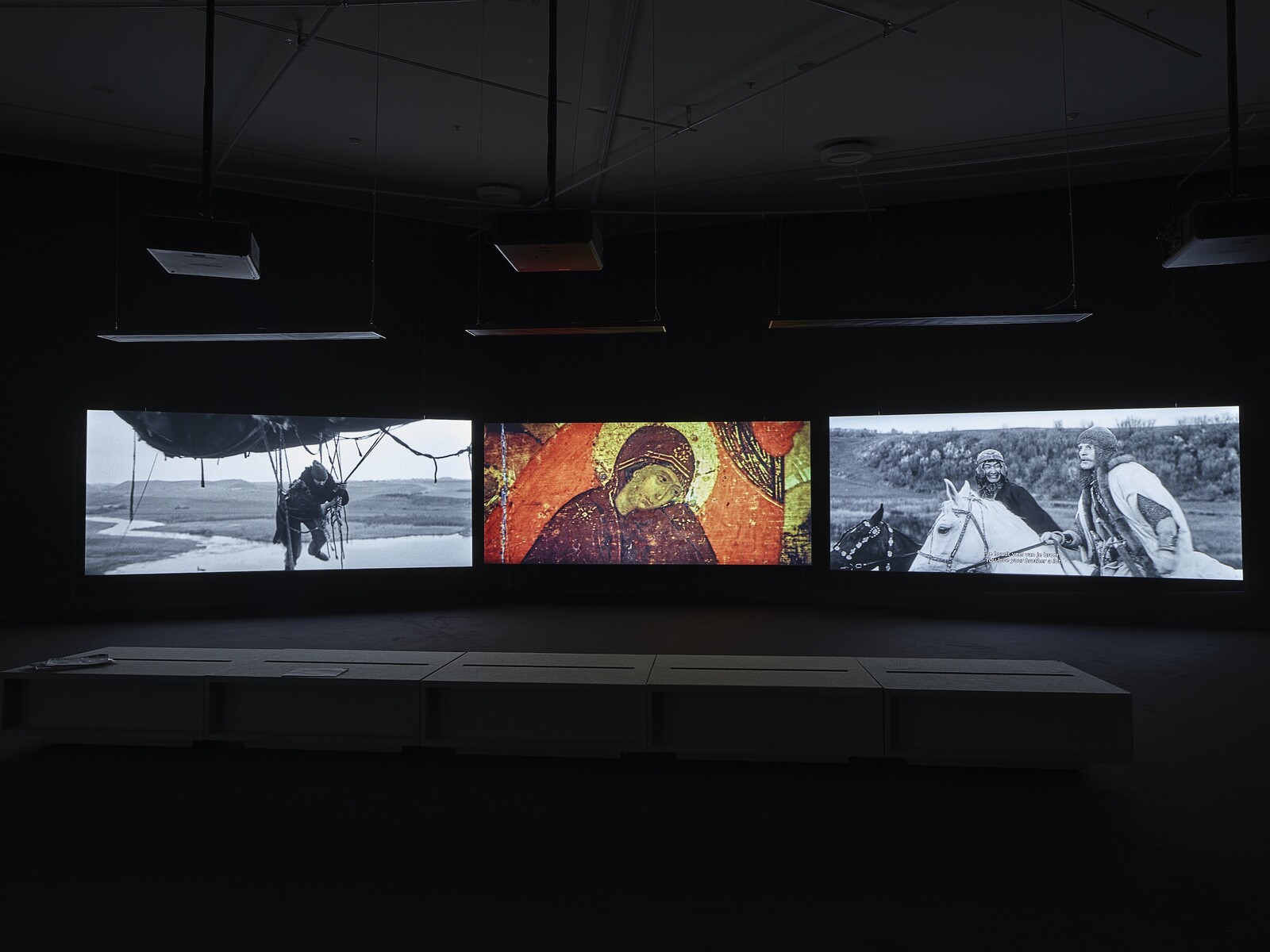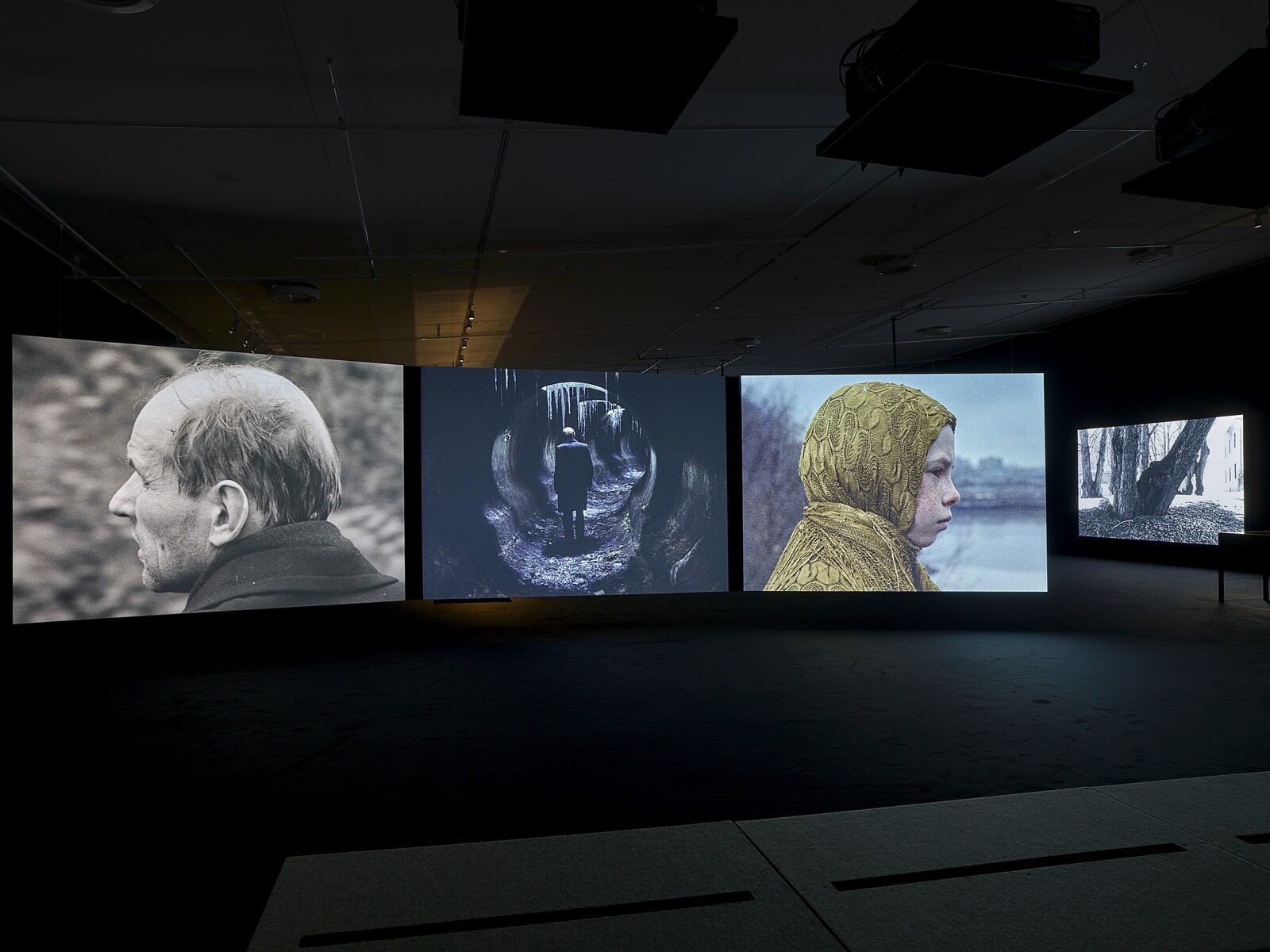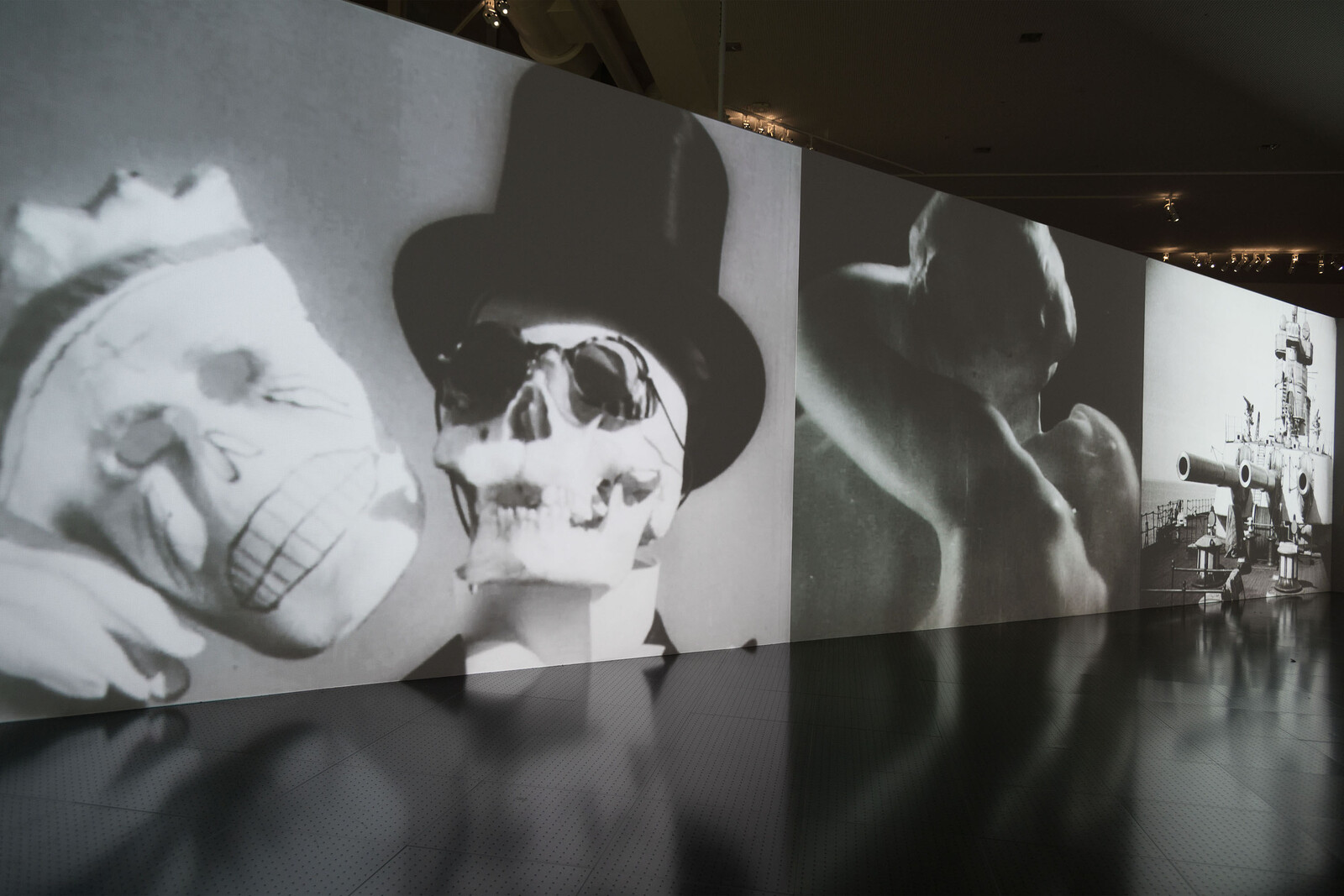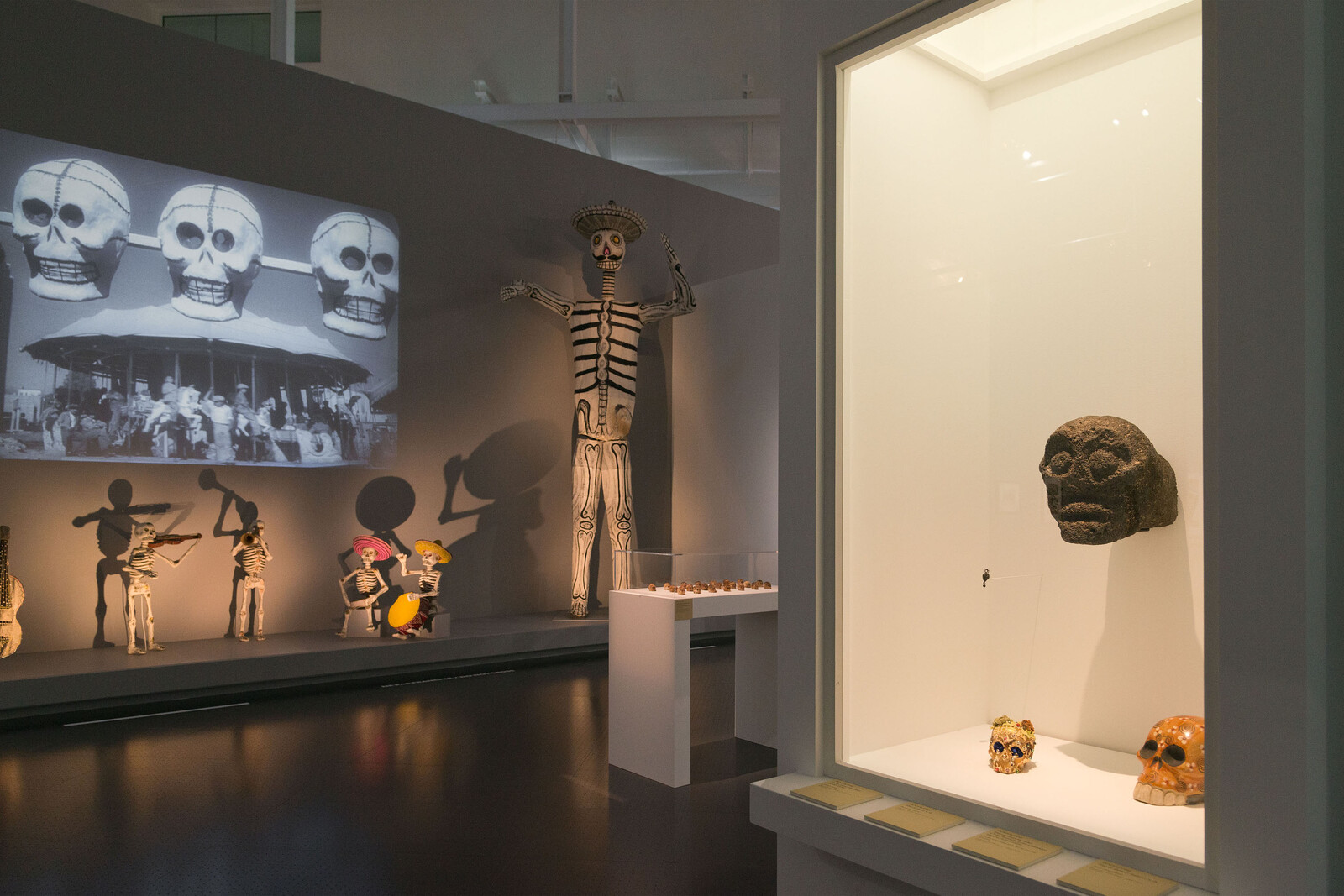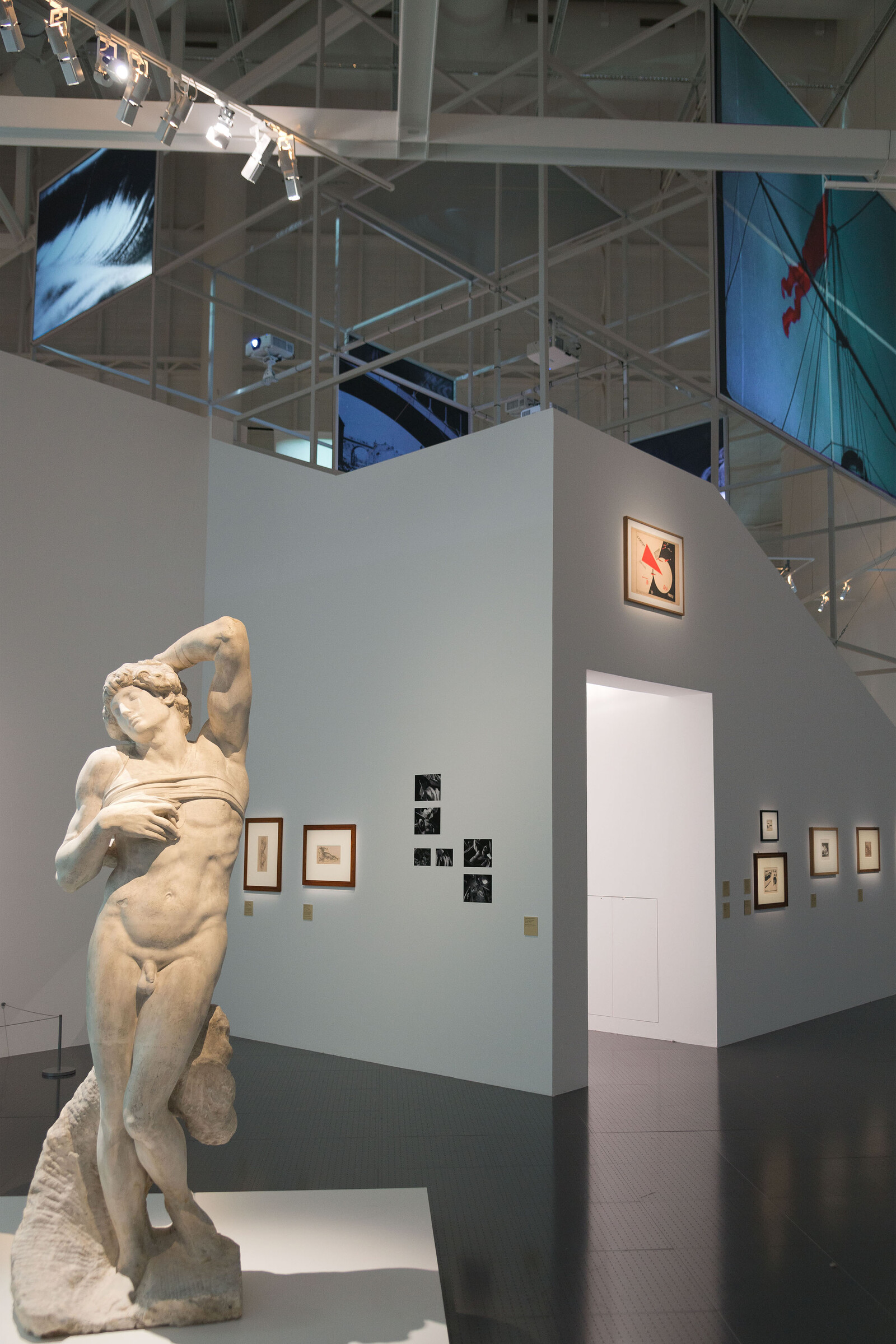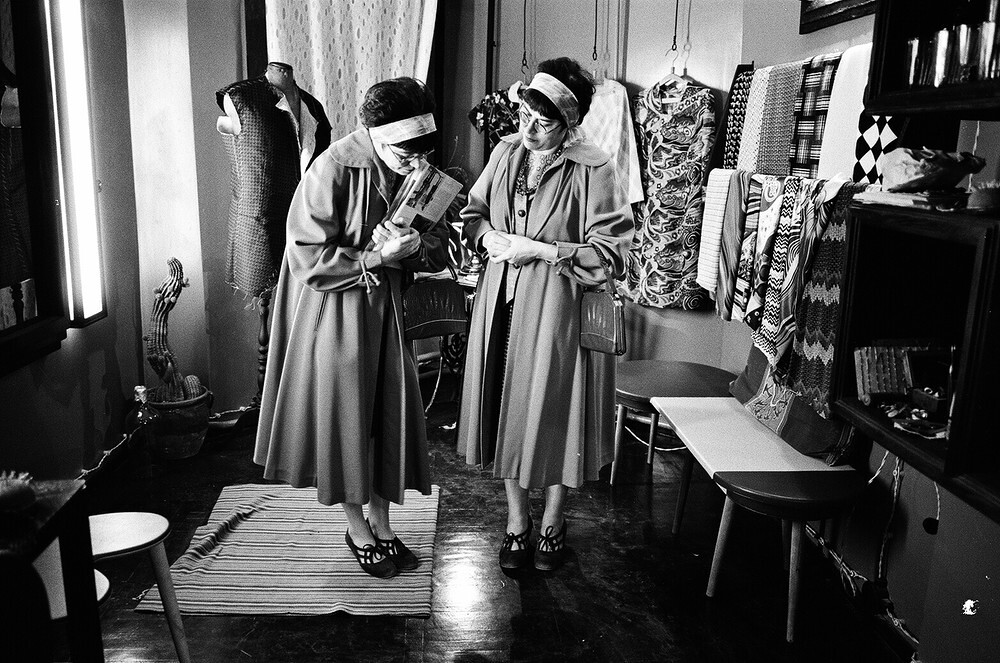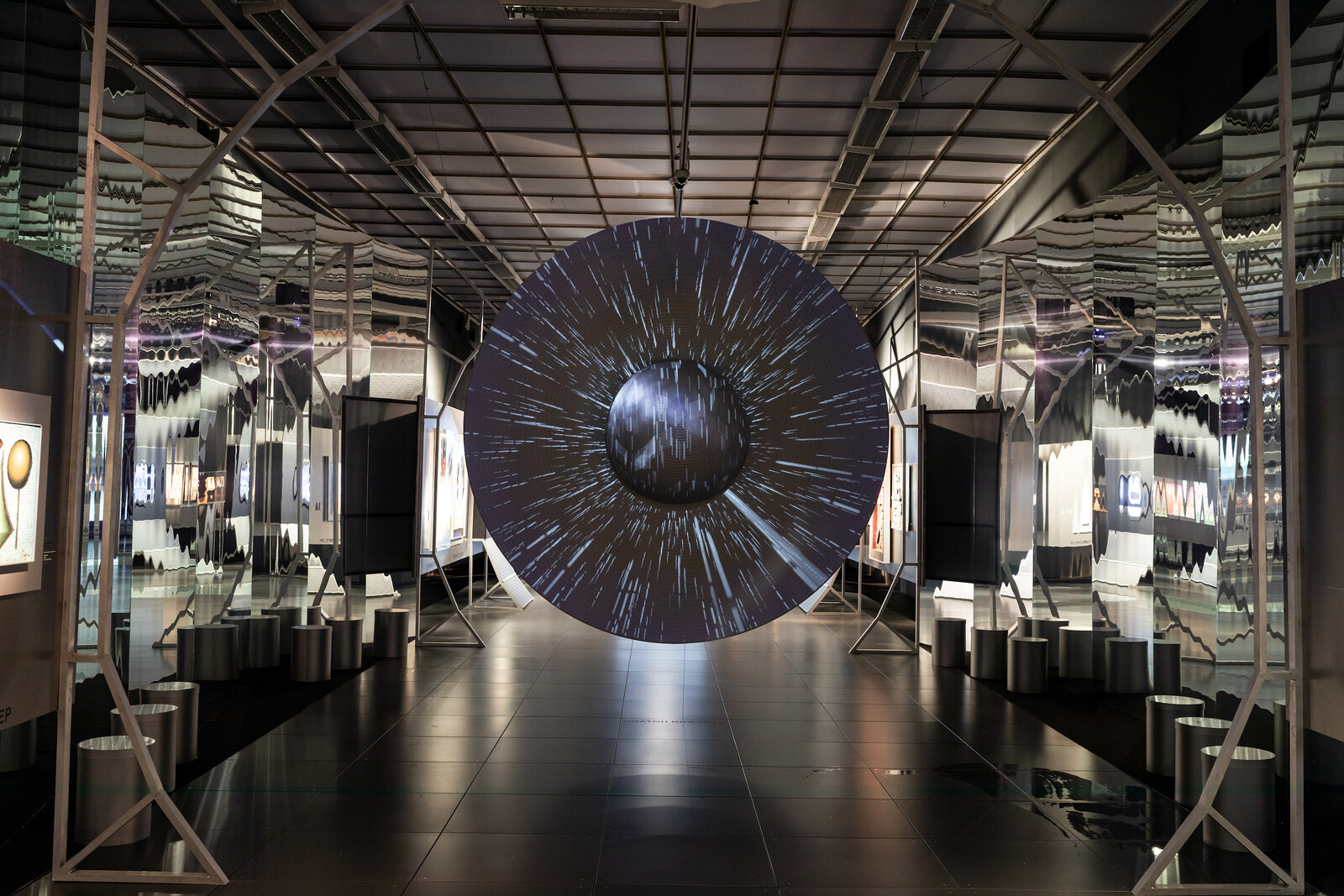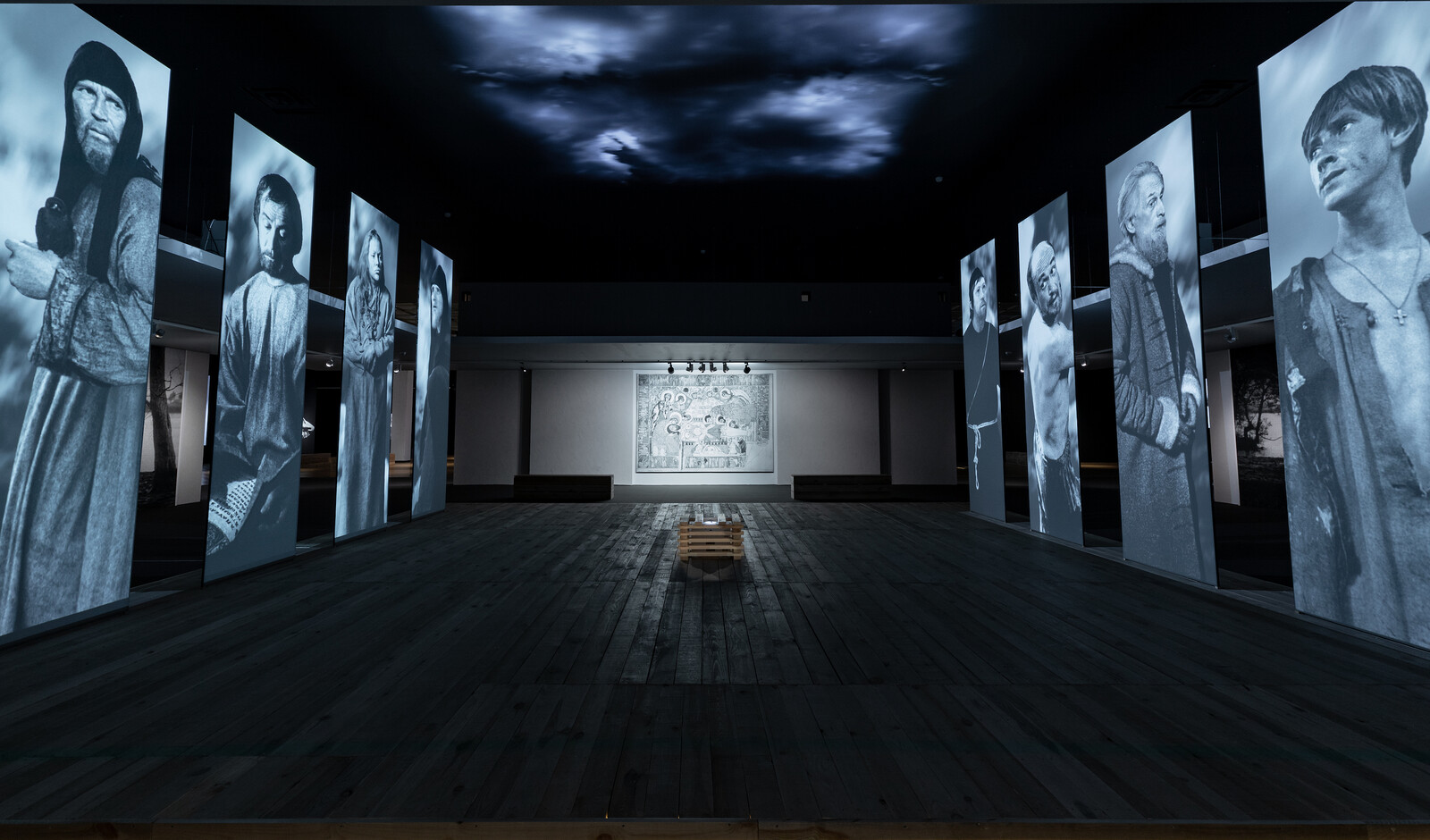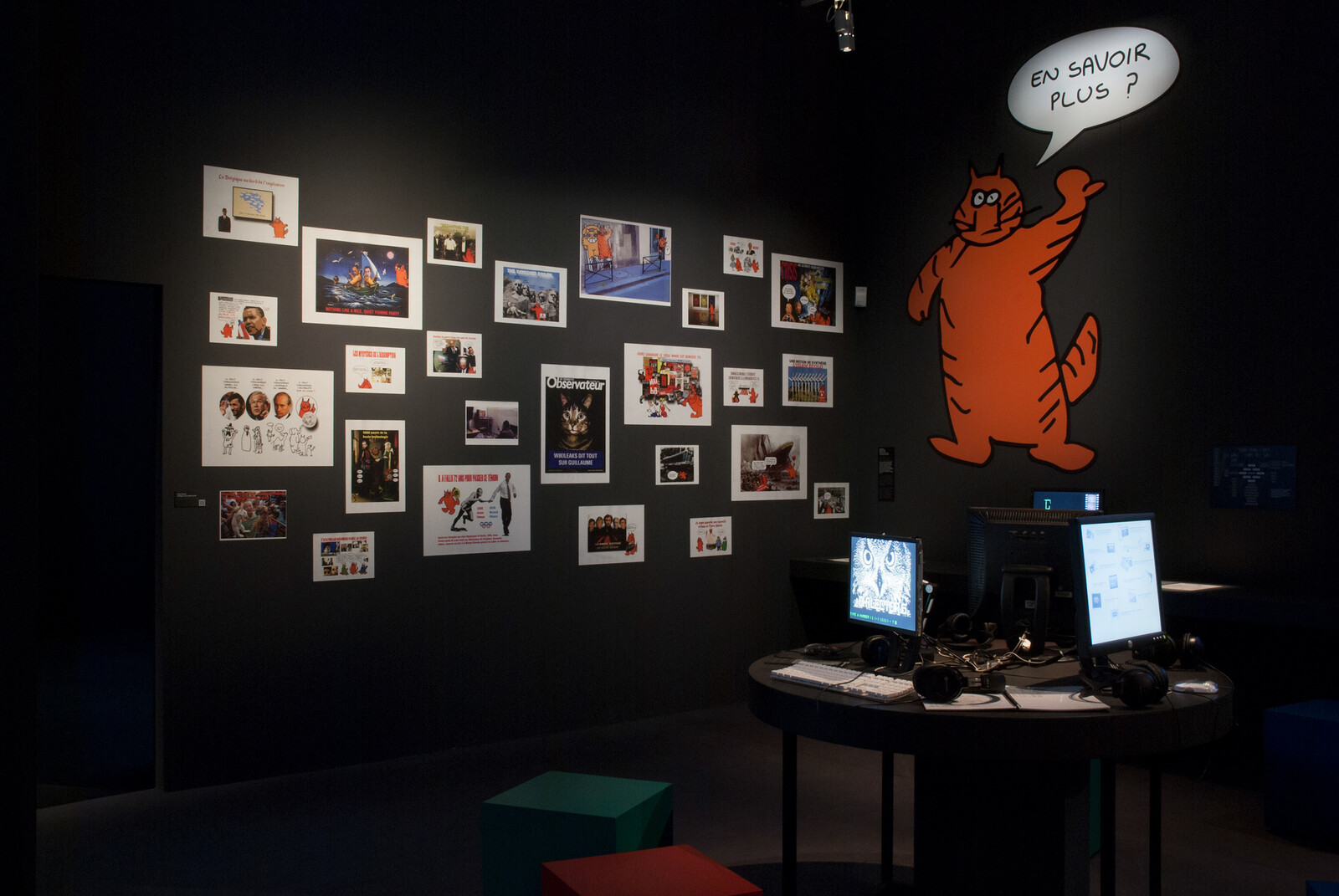The demise of film in its previous modes of production and projection has led to the selective canonization of major filmmakers as artists meriting solo exhibitions in museum spaces. In response, curators have resorted to increasingly ingenious strategies to adapt the medium to the contemporary museum’s infrastructural and institutional conditions. Early exhibitions of film as art frequently focused on its static material apparatus and paraphernalia: cameras and other optical devices, sets and props, screenplays and storyboards, posters and press. Director Stanley Kubrick’s material archive, for example, formed the basis of a massive exhibition organized by the Deutsches Filminstitut Filmmuseum, which has traveled internationally for over a decade. When I saw it in Rome in 2007, its sole dynamic feature was a green-screen device allowing visitors to view themselves within the prehistoric landscape of the prologue to 2001: A Space Odyssey (1968). This interactive apparatus set the scene for my very first digital selfie.
The more ambitious and sophisticated exhibitions of the intervening decade have begun to create a distinct place for film in the museum environment, in part by continuing to blur the boundaries between film, digital media, and installation. A decisive role in the museification of the cinema has been claimed by Jean-Luc Godard, whose Histoire(s) du cinéma (1989–98) simultaneously heralded the end of film as a medium and the beginning of its afterlife as video projection. This project has been tested most recently at Godard’s October 2019 occupation of the Nanterre-Amandiers Centre Dramatique National, at which visitors wandered through public and auxiliary spaces—from auditoriums to dressing rooms—which housed a comprehensive selection of Godard’s work in video and digital media, forming a literal itinerary (parcours) leading up to his most recent film, The Image Book (2018), which continues his multi-decade inquiry into the post-cinematic lives of film. The effect was unexpectedly reminiscent of DAU1, the film-based installation that director Ilya Khrzhanovsky shot in Kharkiv and premiered in Paris in early 2019, in which visitors were encouraged not just to view the interlocking series of (digitally shot) movies and research their archives, but even to live them out within the total installation.
The trend toward digital installation, even of work originally produced on film, runs counter to our growing respect for the archive. Notably, exhibitions of other artists’ work on film increasingly foreground the original material apparatus, following the spectacular example of Tacita Dean’s 2011 installation “Film” in the Tate Modern’s Turbine Hall. The recent exhibition of Andy Warhol at the Art Institute of Chicago, “Andy Warhol From A to B and Back Again” (October 2019–January 2020), for example, pointedly presented his films via live projection from 16mm prints. Seeking a middle ground, the exhibition “Chris Marker: Seven Lives of a Cineaste” at the Cinémathèque française in Paris (May–July 2018) exhibited Marker’s enthusiastic embrace of video and digital formats with a jumble of his obsolete cameras, consoles, and computers. Marker’s work on film, however, was still presented mostly in digital conversion on wall-mounted screens, as a series of punchy video clips. The sole exception showed the limits of this compromise between archival authenticity and digital convenience: Marker’s 1962 masterpiece La Jetée was projected in a separate viewing room on a constant digital loop, with a sign requesting viewers to enter only at the beginning and stay for the duration of the film.
These questions were brought into greater focus for me by three 2019 exhibitions: one of Sergei Eisenstein at the Centre Pompidou-Metz, “The Ecstatic Eye: Sergueï Eisenstein, filmmaker at the crossroads of the arts” (September 2019–February 2020), and two dedicated to Andrei Tarkovsky, “Andrei Tarkovsky—The Exhibition” at the Eye Film Institute in Amsterdam (September–December 2019) and “Free Flight” at the Tretyakov Gallery in Moscow (June–September 2019). Eisenstein and Tarkovsky represent two distinct poles of modernist cinema: montage versus composition, rapidity versus duration, analysis versus immersion. But these exhibitions go far beyond exemplifying the contrast between the two most renowned Soviet auteurs and their current cultural cachet; they represent distinctly different modes by which the film archive is being reclaimed as a resource for digital museum installations, specifically as a form of video installation avant la lettre.
Multi-channel projection proves to be a plausible development of Eisensteinian practice, combining horizontal and vertical planes in a three-dimensional architecture of montage. As suggested by its title, “The Ecstatic Eye” began from the premise that Eisenstein’s films were embedded in other artistic mediums, from graphic art and photography to theatrical set design and folk art. Curators Ada Ackerman and Philippe-Alain Michaud presented Eisenstein’s films amidst a plethora of related paintings, sculptures, and works on paper. Wall-mounted monitors presented extracts from Eisenstein’s Strike (1925), for instance, alongside the physiognomic studies by Johann Kaspar Lavater and J.J. Grandville on which the film explicitly draws in its analysis of class typages, architectural prints by Giovanni Battista Piranesi that inspired the film’s labyrinthine sets, and an excerpt from The Mask of Zorro (1920), highlighting the film’s connection to popular genres. Analogous tableaux were constructed for each of Eisenstein’s major projects, resulting in a labyrinth of screens dispersed across the Constructivist gallery spaces, partly in homage to Eisenstein’s unrealized project “The Glass House.” Most impressive was the sprawling three-channel display of Eisenstein’s “most emblematic sequences” on the wall facing the entrance to the exhibition, made even more evocative by their randomization; like the three bars on a wonky slot machine, the constant recombinations of Eisenstein’s visual obsessions kept disgorging minor jackpots for the mesmerized viewer.
The curators of the two Tarkovsky exhibitions also took their lead from his theoretical rhetoric, which stressed the continuous nature of cinematic representation as something that elapses on screen in time, instead of being constructed across space. Tarkovsky’s fluid, detached long takes have left a distinct trace in video art, from Bill Viola’s oneiric multiscreen panoramas to such patient observational work as Sharon Lockhart’s Double Tide (2009), in which a stationary 16mm camera (later transferred to digital video) records the labor of a solitary female clam-digger on a desolate Maine beach. Stalker (1979) has been directly appropriated in works from Susan Hiller’s multi-channel installation Psi Girls (1999) to Jeremy Millar’s single-channel Ajapeegel (2008). Now curators seem eager to return the favor, retrofitting Tarkovsky’s cinema as immersive video installations, freely re-cutting the films into loops projected on up to three screens at the Eye Film Institute, and up to nine screens at the Tretyakov Gallery, which literally overshadow the material archive and flaunt the film’s narrative exposition and historical contexts.
“Free Flight” at the Tretyakov Gallery was the culminating exhibition in a series of three organized by the AZ Museum striving to place Tarkovsky—who functioned wholly within established institutions—on the landscape of “unofficial” Soviet art. The strategy proved most suggestive in the section reprising a 2018 exhibition at Fondazione Franco Zeffirelli in Florence, “New Flight to Solaris” (May–July 2018), that highlighted the cosmist intuitions common to Tarkovsky and his contemporary painters: a rich array of paintings by unofficial Soviet artists (many of them made after 1991) lined a tunnel-like space loosely modeled on Mikhail Romadin’s set designs for the interiors of the spaceship in Tarkovsky’s Solaris (1972). Other areas of “Free Flight” reprised a 2017 Moscow exhibition that juxtaposed religious paintings by Dmitri Plavinsky (1937–2012) with nine suspended screens projecting excerpts and production footage from Andrei Rublev (1966/1969). A third section (first shown in Moscow in 2016) brought stills from Stalker into conversation with nightmarish paintings by Petr Belenok (1938–1991) and poignant photographs by Viktoria Ivleva (1956–) of the Chernobyl disaster site. In the cavernous spaces of the exhibition hall, absent any articulated argument, the effect was to transform Tarkovsky from the director of long, complicated film narratives produced within the state-industrial apparatus into the author of discrete, private dreamscapes that tapped into an artistic and intellectual project bridging “official” and “unofficial” art.
Tarkovsky’s unabashed conversion into a video artist was even more pronounced at the Eye Film Institute, where longer loops of 20–25 minutes focused on dialogue-free sequences: dreams, musical interludes, and the off-screen reading of poems. Andrei Rublev was represented as a three-screen projection featuring black-and-white excerpts from part one on the left and from part two on the right, flanking the color epilogue of icons. In the underlit rooms, with strains of Bach wafting through, the result was a temple-like atmosphere, an impression that was confirmed when, as I discussed the montage from Nostalghia (1983) with my companion, one museum visitor approached and angrily asked us to let her watch “in silence.”
Tarkovsky’s amenability to multi-screen projection was evident in the two-channel installation of Mirror (1975), a complex, autobiographical narrative of about 20 episodes, which switch back and forth between several key periods of Tarkovsky’s visual memory: early childhood, early adolescence, and the present moment. It is the closest Tarkovsky got to a montage film, which allowed the curators to shift emphasis from the temporal unfolding of extended fragments to their calculated juxtaposition in space: the mother’s dream on the left against a later scene of the grown protagonist’s son alone in an empty apartment; newsreel footage of the Sino-Soviet conflict on the left against Second World War footage on the right. The sequences’ soundtracks, playing from clearly differentiated sources, augmented the complex layering of images as, for instance, a baroque aria accompanied the filmmaker’s father Arsenii Tarkovsky reading his poetry from the right.
Although the Tarkovsky exhibitions strained hard to build on his self-styled legend as a martyr to art in a time of repression, the de-territorialization of film sequences confirmed their profound disregard of his material archive. Not only are the films themselves shown without mention of their original medium, provenance, state of restoration, and so on; a similar reticence accompanied the material objects. Both in Moscow and Amsterdam, original documents were displayed alongside facsimiles, while photographs by various authors were shown mostly in new, enlarged prints, likewise without note of date, dimension or provenance. In the pervading gloom, images and documents float alongside the film sequences in a high-resolution vacuum, and the exhibition reads like a speculative reconstruction of Tarkovsky’s Instagram story. This indifference to artifact and medium stands in stark tension with the heavy materiality of Tarkovsky’s film world, in which time not only elapses on screen, but is experienced as a force resistant to the gaze. As the art collective Metahaven have written in their 2018 book Digital Tarkovsky, Tarkovsky’s film world not only exists in time, but also exists of time. This stubborn temporality prevents the medium from being disregarded as an indifferent platform, forcing viewers constantly to face “the discrepancy between the speed of and on the platform, and the speed of lived experience under the atmospheric omnipresence of all-encompassing computational force.”2 In this sense, the Tarkovsky exhibitions are lost opportunities to confront the singular textures of visual experience that, for all its convergences with video, continue to mark film as a technological, historical, and political apparatus distinct from, even resistant to, the all-levelling imperialism of the digital.
https://www.art-agenda.com/features/256823/ilya-khrzhanovsky-s-dau.
Metahaven, Digital Tarkovsky (Moscow: Strelka Press, 2018), 120.

